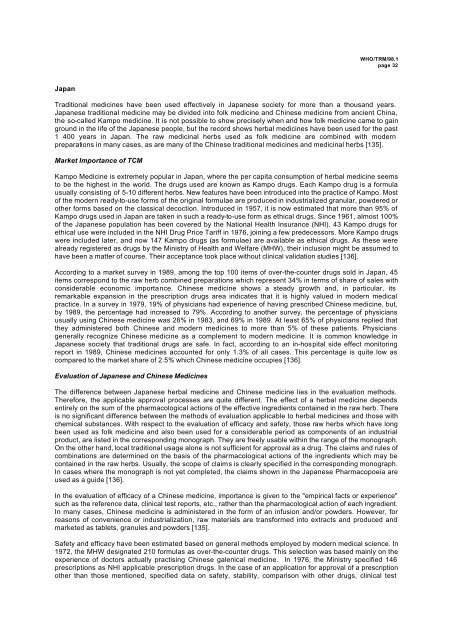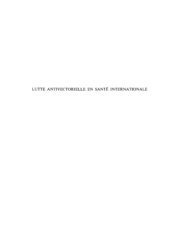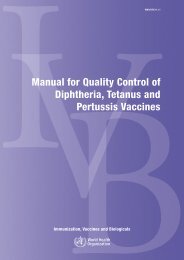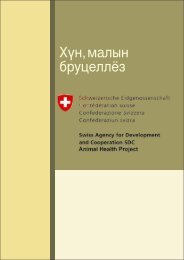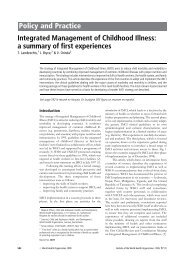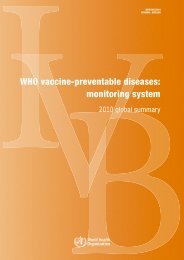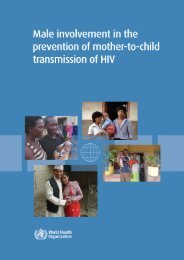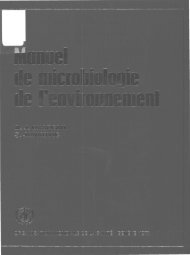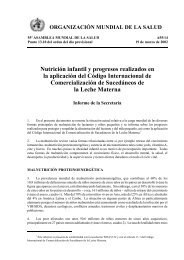Regulatory Situation of Herbal Medicines A worldwide Review
Regulatory Situation of Herbal Medicines A worldwide Review
Regulatory Situation of Herbal Medicines A worldwide Review
Create successful ePaper yourself
Turn your PDF publications into a flip-book with our unique Google optimized e-Paper software.
WHO/TRM/98.1page 32JapanTraditional medicines have been used effectively in Japanese society for more than a thousand years.Japanese traditional medicine may be divided into folk medicine and Chinese medicine from ancient China,the so-called Kampo medicine. It is not possible to show precisely when and how folk medicine came to gainground in the life <strong>of</strong> the Japanese people, but the record shows herbal medicines have been used for the past1 400 years in Japan. The raw medicinal herbs used as folk medicine are combined with modernpreparations in many cases, as are many <strong>of</strong> the Chinese traditional medicines and medicinal herbs [135].Market Importance <strong>of</strong> TCMKampo Medicine is extremely popular in Japan, where the per capita consumption <strong>of</strong> herbal medicine seemsto be the highest in the world. The drugs used are known as Kampo drugs. Each Kampo drug is a formulausually consisting <strong>of</strong> 5-10 different herbs. New features have been introduced into the practice <strong>of</strong> Kampo. Most<strong>of</strong> the modern ready-to-use forms <strong>of</strong> the original formulae are produced in industrialized granular, powdered orother forms based on the classical decoction. Introduced in 1957, it is now estimated that more than 95% <strong>of</strong>Kampo drugs used in Japan are taken in such a ready-to-use form as ethical drugs. Since 1961, almost 100%<strong>of</strong> the Japanese population has been covered by the National Health Insurance (NHI). 43 Kampo drugs forethical use were included in the NHI Drug Price Tariff in 1976, joining a few predecessors. More Kampo drugswere included later, and now 147 Kampo drugs (as formulae) are available as ethical drugs. As these werealready registered as drugs by the Ministry <strong>of</strong> Health and Welfare (MHW), their inclusion might be assumed tohave been a matter <strong>of</strong> course. Their acceptance took place without clinical validation studies [136].According to a market survey in 1989, among the top 100 items <strong>of</strong> over-the-counter drugs sold in Japan, 45items correspond to the raw herb combined preparations which represent 34% in terms <strong>of</strong> share <strong>of</strong> sales withconsiderable economic importance. Chinese medicine shows a steady growth and, in particular, itsremarkable expansion in the prescription drugs area indicates that it is highly valued in modern medicalpractice. In a survey in 1979, 19% <strong>of</strong> physicians had experience <strong>of</strong> having prescribed Chinese medicine, but,by 1989, the percentage had increased to 79%. According to another survey, the percentage <strong>of</strong> physiciansusually using Chinese medicine was 28% in 1983, and 69% in 1989. At least 65% <strong>of</strong> physicians replied thatthey administered both Chinese and modern medicines to more than 5% <strong>of</strong> these patients. Physiciansgenerally recognize Chinese medicine as a complement to modern medicine. It is common knowledge inJapanese society that traditional drugs are safe. In fact, according to an in-hospital side effect monitoringreport in 1989, Chinese medicines accounted for only 1.3% <strong>of</strong> all cases. This percentage is quite low ascompared to the market share <strong>of</strong> 2.5% which Chinese medicine occupies [136].Evaluation <strong>of</strong> Japanese and Chinese <strong>Medicines</strong>The difference between Japanese herbal medicine and Chinese medicine lies in the evaluation methods.Therefore, the applicable approval processes are quite different. The effect <strong>of</strong> a herbal medicine dependsentirely on the sum <strong>of</strong> the pharmacological actions <strong>of</strong> the effective ingredients contained in the raw herb. Thereis no significant difference between the methods <strong>of</strong> evaluation applicable to herbal medicines and those withchemical substances. With respect to the evaluation <strong>of</strong> efficacy and safety, those raw herbs which have longbeen used as folk medicine and also been used for a considerable period as components <strong>of</strong> an industrialproduct, are listed in the corresponding monograph. They are freely usable within the range <strong>of</strong> the monograph.On the other hand, local traditional usage alone is not sufficient for approval as a drug. The claims and rules <strong>of</strong>combinations are determined on the basis <strong>of</strong> the pharmacological actions <strong>of</strong> the ingredients which may becontained in the raw herbs. Usually, the scope <strong>of</strong> claims is clearly specified in the corresponding monograph.In cases where the monograph is not yet completed, the claims shown in the Japanese Pharmacopoeia areused as a guide [136].In the evaluation <strong>of</strong> efficacy <strong>of</strong> a Chinese medicine, importance is given to the "empirical facts or experience"such as the reference data, clinical test reports, etc., rather than the pharmacological action <strong>of</strong> each ingredient.In many cases, Chinese medicine is administered in the form <strong>of</strong> an infusion and/or powders. However, forreasons <strong>of</strong> convenience or industrialization, raw materials are transformed into extracts and produced andmarketed as tablets, granules and powders [135].Safety and efficacy have been estimated based on general methods employed by modern medical science. In1972, the MHW designated 210 formulas as over-the-counter drugs. This selection was based mainly on theexperience <strong>of</strong> doctors actually practising Chinese galenical medicine. In 1976, the Ministry specified 146prescriptions as NHI applicable prescription drugs. In the case <strong>of</strong> an application for approval <strong>of</strong> a prescriptionother than those mentioned, specified data on safety, stability, comparison with other drugs, clinical test


